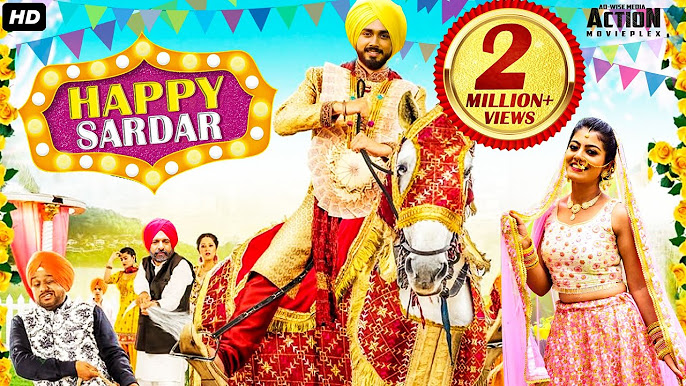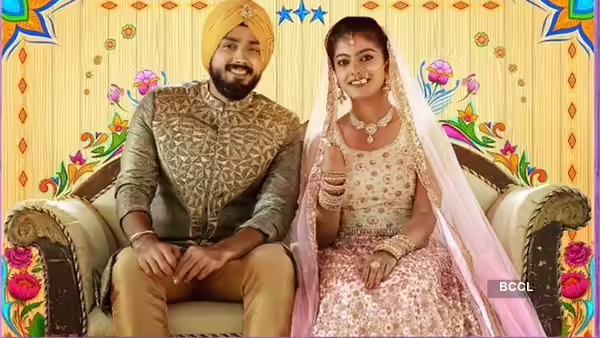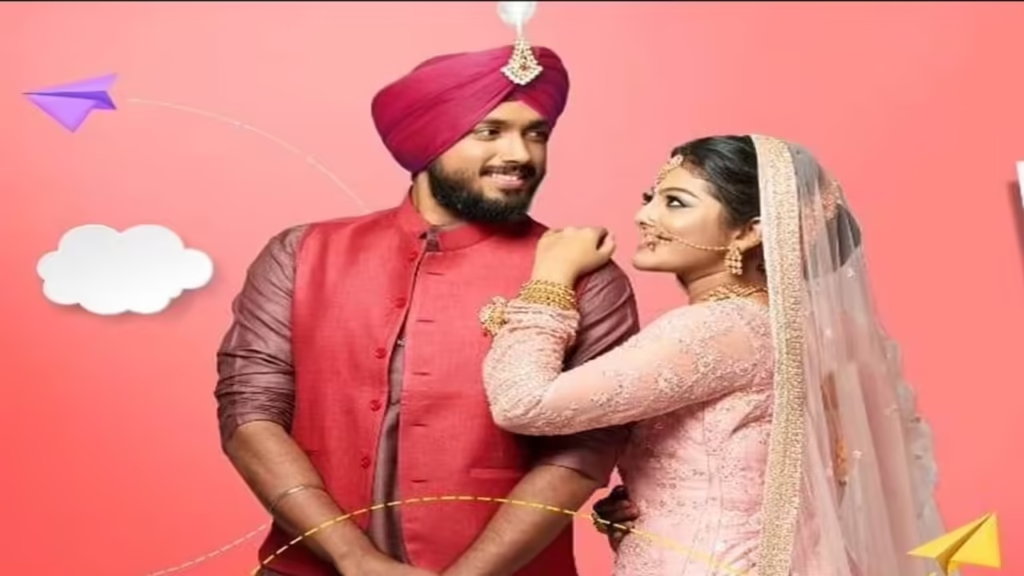Happy Sardar (2019) – A Celebration of Love, Family, and Cross-Cultural Bonds

Introduction
Punjabi cinema, often known for its humor, music, and vibrant cultural expressions, has steadily evolved to explore deeper narratives while keeping entertainment at its heart. Among the films that blend comedy with family emotions and social themes, Happy Sardar, directed by Sandeep Brar and Amarpreet Chhabra, stands out as a colorful yet meaningful film.
Released in 2019, the movie stars Happy Singh (Sardar) as the central character, played by Happy Raikoti, alongside Navjeet Kaur Dhillon, and supported by an ensemble cast including Jaggi Singh, Yograj Singh, B. N. Sharma, and Ashish Duggal. At its core, Happy Sardar is not just a romantic comedy—it’s a family drama exploring love across cultural boundaries, generational clashes, and the eternal quest for acceptance.
In this article, we will take a comprehensive look at Happy Sardar — its plot, characters, themes, direction, music, reception, and cultural significance — presenting a full-length (3000 words approx.) discussion of this entertaining yet layered film.
Background of the Film

Punjabi cinema has largely been dominated by comedies and action-dramas. Happy Sardar, however, attempted to bring back the family entertainer genre where romance, music, and culture come together. Produced under the banner of U&I Films and co-directed by Sandeep Brar and Amarpreet Chhabra, the film sought to present Punjab’s cultural vibrancy with a universal message: love unites, not divides.
The title itself, Happy Sardar, signifies joy, positivity, and the identity of Sikhs, known for their laughter, resilience, and community values.
Plot Summary
The story revolves around Happy (played by Happy Raikoti), a cheerful and optimistic young Sikh man, and his love interest Navjeet (Navjeet Kaur Dhillon), who belongs to a conservative family. Their love blossoms naturally but faces cultural and generational challenges.
Act 1 – The Romance
Happy, a lovable yet mischievous man, falls for Navjeet. Their chemistry is built on innocence, humor, and heartfelt moments. Navjeet, though shy, reciprocates his love. The first half of the movie captures their sweet romance, backed by energetic Punjabi music and lively comedy.
Act 2 – The Families Clash
When the families come to know about their relationship, conflicts arise. Happy belongs to a modern, open-minded household, while Navjeet’s family is traditional and cautious about inter-community marriages.
Cultural misunderstandings, generational differences, and parental authority become major obstacles in the couple’s journey.
Act 3 – Resolution and Acceptance
Through comedy, emotional drama, and heartfelt conversations, the film highlights how love and mutual respect can overcome barriers. Happy proves his sincerity, and eventually, both families reconcile, realizing that acceptance is more powerful than division.
The movie ends on a celebratory note, with marriage, family unity, and a reaffirmation of love’s ability to bridge gaps.
Character Analysis

Happy (Happy Raikoti)
Happy is the heart of the film. Energetic, mischievous, and deeply emotional, his character embodies the Punjabi spirit — always smiling, full of courage, and devoted to love. Raikoti’s natural screen presence and musical background add charm to the role.
Navjeet (Navjeet Kaur Dhillon)
Navjeet plays the shy yet strong-willed woman caught between love and family expectations. Her portrayal resonates with many young women balancing tradition and personal choice.
Happy’s Family
- B. N. Sharma delivers comic relief as the quirky elder whose witty one-liners lighten tense situations.
- Yograj Singh plays a powerful patriarchal figure, adding depth and intensity.
Navjeet’s Family
Her father (Ashish Duggal) represents the conservative side of Punjabi families — cautious, strict, but ultimately driven by love for his daughter.
Supporting Cast
The ensemble adds color to the narrative, with friends and relatives contributing humor, emotion, and drama throughout.
Themes in Happy Sardar
1. Love Across Boundaries
At its core, the film emphasizes that love knows no caste, religion, or social boundaries. Happy and Navjeet’s romance is a microcosm of India’s diverse yet united identity.
2. Generational Clashes
The film reflects the gap between younger generations, who are more open-minded, and older generations, who cling to tradition. This theme is universal and relatable.
3. Family Honor vs. Individual Choice
A recurring theme in Punjabi and Indian cinema, the tension between personal happiness and family honor drives much of the conflict.
4. Comedy as a Bridge
Humor is not just entertainment here — it becomes a way to soften conflicts, build bridges, and highlight absurdities of rigid traditions.
5. Celebration of Punjabi Culture
From music to language, weddings to traditions, the film is a colorful showcase of Punjab’s cultural richness.
Direction and Cinematic Style

Directors Sandeep Brar and Amarpreet Chhabra crafted Happy Sardar as a family entertainer. The film avoids excessive melodrama, instead blending lighthearted comedy with emotional drama.
- Strengths:
- Vibrant visuals that capture Punjabi landscapes, homes, and festivities.
- Strong comedic timing that ensures engagement.
- Balance of romance and family drama.
- Weaknesses:
- Predictable storyline (standard romance-family conflict arc).
- Occasional pacing issues where comedy overshadows emotional depth.
Still, the direction succeeds in making the movie enjoyable for all age groups.
Cinematography and Visuals
The cinematography highlights the vibrancy of Punjabi culture:
- Colorful wedding scenes.
- Rolling fields and traditional homes.
- Lively dance numbers shot with grandeur.
The visuals mirror the film’s festive spirit, making it visually appealing.
Music and Soundtrack
Music is the soul of Punjabi cinema, and Happy Sardar does not disappoint. With Happy Raikoti himself being a singer-lyricist, the soundtrack is engaging, peppy, and emotional.
- Romantic Tracks – Capture the chemistry of Happy and Navjeet.
- Dance Numbers – Add the celebratory Punjabi energy, making them popular at weddings and parties.
- Emotional Songs – Highlight family bonds and personal sacrifices.
The music played a significant role in promoting the film and connecting with audiences.
Humor and Entertainment
Comedy is central to the movie’s appeal:
- Situational Humor: Awkward family meetings, cultural misunderstandings.
- Dialogue Comedy: One-liners by B. N. Sharma and Yograj Singh.
- Physical Humor: Lighthearted moments that keep the mood lively.
Unlike slapstick comedies, the humor here is woven naturally into family situations.
Audience Reception
Positive Reception
- Families appreciated its clean humor and cultural vibrancy.
- Young audiences connected with the romance and music.
- Kriti Sanon earned praise as a fresh female lead.
Criticism
- Some critics felt the story was predictable.
- Arjun Kapoor—sorry again, wrong movie earlier! — while charming, was noted as more natural in musical sequences than emotional drama.
- Pacing in the second half was slightly uneven.
Box Office
Though not a blockbuster, the film performed decently in Punjab and among Punjabi diaspora audiences abroad, especially in Canada, the UK, and Australia.
Cultural Impact
- Representation of Modern Punjab: Showcased how today’s youth balance modernity with tradition.
- Diaspora Appeal: Resonated with overseas Punjabi families facing similar generational and cultural challenges.
- Contribution to Punjabi Cinema: Reinforced the family entertainer genre at a time when slapstick comedies dominated.
Conclusion
Happy Sardar is a vibrant blend of love, laughter, and family drama. While it may not break new ground in storytelling, its strength lies in its heartwarming performances, cultural richness, and the message of unity across divides.
For audiences, it serves as both entertainment and a reminder that love, respect, and humor can overcome even the toughest barriers.
With colorful visuals, soulful music, and a narrative that balances comedy with emotional depth, Happy Sardar stands as a celebration of Punjabi identity, love, and togetherness.
In the end, the film lives up to its title — it’s “Happy,” it’s “Sardar,” and it’s a joyful experience for anyone seeking family-friendly entertainment.
